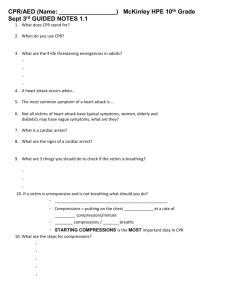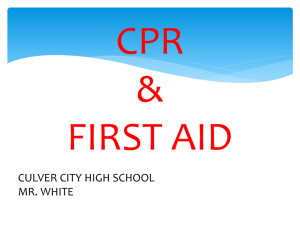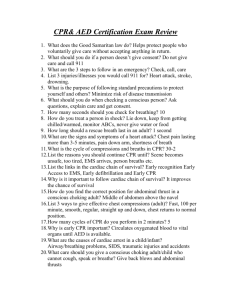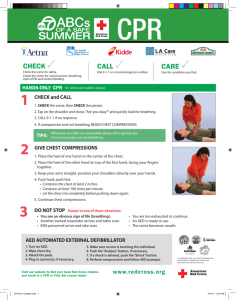CPR/First Aid Study Guide
advertisement
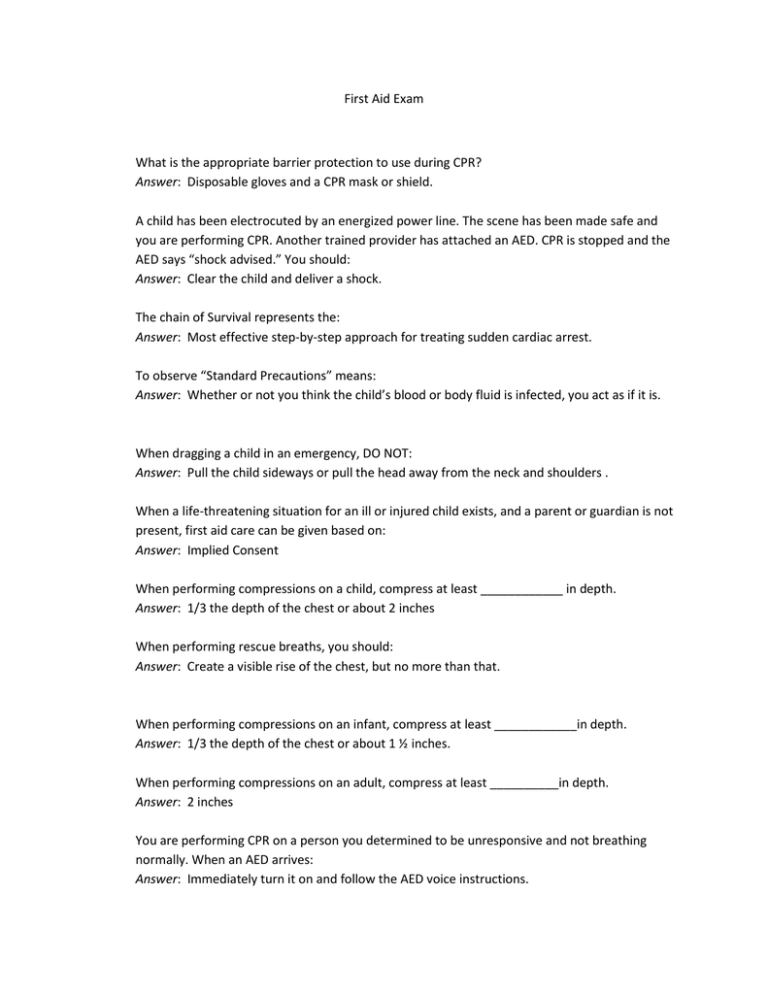
First Aid Exam What is the appropriate barrier protection to use during CPR? Answer: Disposable gloves and a CPR mask or shield. A child has been electrocuted by an energized power line. The scene has been made safe and you are performing CPR. Another trained provider has attached an AED. CPR is stopped and the AED says “shock advised.” You should: Answer: Clear the child and deliver a shock. The chain of Survival represents the: Answer: Most effective step-by-step approach for treating sudden cardiac arrest. To observe “Standard Precautions” means: Answer: Whether or not you think the child’s blood or body fluid is infected, you act as if it is. When dragging a child in an emergency, DO NOT: Answer: Pull the child sideways or pull the head away from the neck and shoulders . When a life-threatening situation for an ill or injured child exists, and a parent or guardian is not present, first aid care can be given based on: Answer: Implied Consent When performing compressions on a child, compress at least ____________ in depth. Answer: 1/3 the depth of the chest or about 2 inches When performing rescue breaths, you should: Answer: Create a visible rise of the chest, but no more than that. When performing compressions on an infant, compress at least ____________in depth. Answer: 1/3 the depth of the chest or about 1 ½ inches. When performing compressions on an adult, compress at least __________in depth. Answer: 2 inches You are performing CPR on a person you determined to be unresponsive and not breathing normally. When an AED arrives: Answer: Immediately turn it on and follow the AED voice instructions. You are providing care to a responsive child who has been injured in an accident. Blood is streaming heavily out of a large wound in the leg. To control the bleeding you should: Answer: Apply direct pressure with a clean absorbent pad. The speed, or rate, of chest compressions when performing CPR for any age is at least _______ times per minute. Answer: 100 An injured child is shivering and his tissue color is pale. He is pleading with you for a drink of water. You should: Answer: Give nothing to drink and cover him with a blanket to maintain normal temperature. You are attending to a responsive child injured in a skateboard accident. He has sharp pain and swelling in the right leg, which looks strangely bent. EMS has been activated. You should: Answer: Manually stabilize the injured leg. You are attending to a child who collapsed suddenly. You determine she is unresponsive and note she is making weird, periodic gasping sounds that don’t seem normal or effective. You should: Answer: Start CPR beginning with chest compressions. You are attending to an unresponsive child you think has had an accidental drug overdose. She is breathing normally and EMS has been activated. You place the child on her side in the recovery position. Why? Answer: To maintain and protect her airway. You are caring for an responsive child who thrown from a bicycle. He was not wearing a helmet. You notice he has blood visible on his head and face and he is complaining of numbness in his fingers. You should: Answer: Place you hands on both sides of his head to keep his head stabilized. Chest compressions during CPR should be: Answer: Hard and fast and interrupted as little as possible. You have assisted a child with asthma in using a prescribed metered-dosed inhaler. Ten minutes later the child is bent over and can’t stop coughing. You should: Answer: Activate EMS A visibly upset mother rushes to you with her 8-month-old infant in her arms. The infant is moving but his face is blue and he is not making any noise. The mother says he swallowed a small part of a toy and can’t breathe. To care for this infant, perform __________ until the obstruction is relieved or he becomes unresponsive. Answer: Continuous cycles of 5 back blows and 5 chest thrusts. The correct ratio of compressions to breaths when performing child or infant CPR is: Answer: 30:2 You are caring for an older child who has been stung by a bee and is severely allergic to them. She has an epinephrine auto-injector. Her lips and face are swelling quickly. You should: Answer: Assist her to self-administer the epinephrine. You are providing care to a child you suspect is experiencing heat exhaustion. All of the following treatments are correct, EXCEPT: Answer: Cover the child’s head and neck to help retain body heat. After delivering a shock with an AED, you should: Answer: Immediately resume CPR, starting with chest compressions, and follow any additional voice instructions given by the AED. You are called to attend to a child who collapsed while playing outside on a hot day. He has an altered mental status and his skin is hot and sweaty. EMS has been activated. You should: Answer: Spray or pour water on the child and fan him. You are caring for a child who is complaining that his fingers are numb after being outside in the extreme winter cold. His fingers look pale, and they feel very cold and hard. EMS has been activated. You should: Answer: Place a sterile dressing between his fingers and await EMS. You have been called to provide care for a 3-year-old child who was discovered drinking from an open bottle of skin care lotion. Other than crying loudly when you quickly take the bottle away, she appears fine. You should: Answer: Call the National Poison Help Hotline at 800-222-1222 for directions on what to do. You are in the school cafeteria supervising lunch. At a nearby table a child starts coughing loudly and forcefully. Another supervisor yells, “Please help her, she’s choking!” You should: Answer: Encourage the child to cough. While on a rainy hiking trip, you are attending to a responsive child you suspect of experiencing hypothermia. You have taken him inside to a warmer location and have removed his wet clothes. You have covered him with a blanket. EMS is not readily available. Next, you should: Answer: Begin active rewarming by placing him near a heat source.
